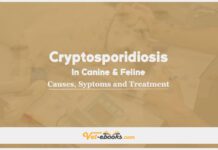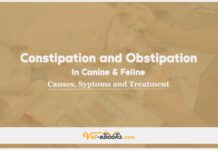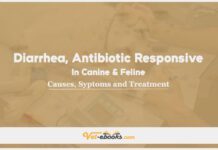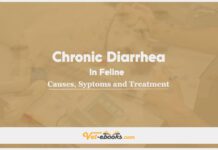Cryptococcosis In Canine and Feline: Causes, Symptoms and Treatment
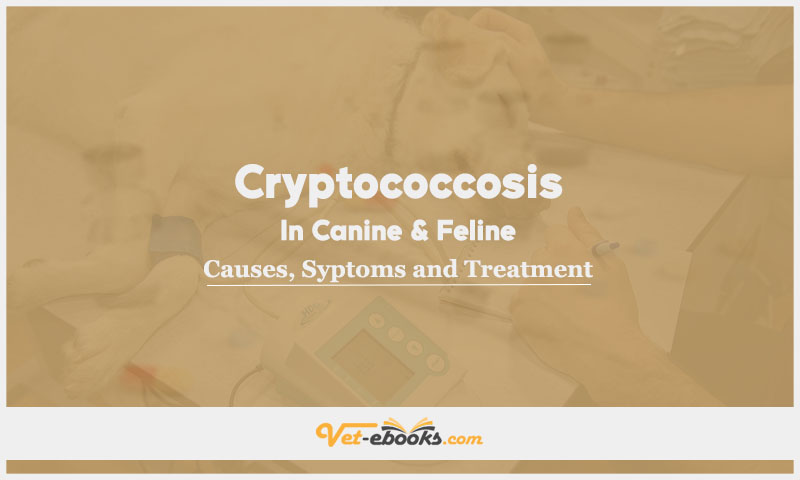
Overview
It is a fungal infection that can occur systemically or in a localized manner, resulting in the development of granulomas. In cats, these granulomas typically form in the nose, sinuses, and eyes, while in dogs, they are commonly found in the brain, nasal passages, and sinuses. caused by cryptococcus spp
Causes of Cryptococcosis In Canine and Feline
Causes:
it depends on the immune system so any Exposure to Cryptococcal organisms(C. neoformans , C. gattii.) and the immune system has no ability to prevent their colonization and tissue invasion can cause the infection.
Risk factors:
- Exposure to soil and environment that has been disturbed.
- Diseases that cause immunosuppression like feline leukemia virus (FeLV) or feline immunodeficiency virus (FIV) considered a risk factor for Cryptococcosis.
Pathogenesis of Cryptococcosis In Canine and Feline
- Cryptococcus neoformans is an environmental yeast-like fungus with the ability to form a heteropolysaccharide capsule within tissues.
- It is primarily found in bird droppings and decaying vegetation, where it can persist for up to 2 years.
- Infection typically begins with the yeast localizing in nasal passages after inhalation, with some organisms potentially reaching the terminal airways to establish a lung infection, although this is rare.
- Hematogenous dissemination to the brain, eyes, lymph nodes, and other tissues is a possible progression of the infection, and there is also potential for local spread to the skin of the nose, eyes, and lymph nodes.
Symptoms (History & Physical Examination) of Cryptococcosis In Canine and Feline
History:
Dogs: may exhibit various symptoms, including:
- neurological issues like seizures, ataxia, and paresis.
- Ocular signs such as periorbital swelling, blindness, uveitis, and hyphema may also be present.
- Skin ulceration, lymphadenopathy, upper respiratory symptoms, labored breathing, coughing.
- Gastrointestinal problems like vomiting, diarrhea, and anorexia can occur.
Cats: on the other hand, typically show nasal discharge and ocular signs. They may also display neurological symptoms such as seizures, disorientation, and vestibular signs. Granulomatous tissue may be observed at the nares, along with firm swellings over the bridge of the nose. Lymphadenopathy is another possible symptom, while respiratory abnormalities are less commonly observed in cats.
Physical Examination:
- A mild fever is present in less than 50% of patients.
- In dogs, symptoms may include nasal discharge, multifocal CNS (central nervous system) abnormalities, ataxia, and anterior uveitis.
- Cats may exhibit symptoms such as respiratory noise (stertor), nasofacial swelling, ulcerated crusting skin lesions on the head, lymphadenopathy, neurologic abnormalities (behavior changes, circling, vestibular signs, ataxia), and ocular abnormalities (blindness, optic neuritis, retinal detachment).
Diagnosis of Cryptococcosis In Canine and Feline
1- From History and Physical Examination
2- Diagnostic Procedures:
- CBC results typically show anemia of chronic disease, which is characterized by normocytic and normochromic red blood cells. Eosinophilia may occasionally be observed in some cats.
- The serum biochemistry profile is usually within normal ranges, although mild elevations in globulin proteins may be present.
- Imaging of the nasopharynx, including radiographs, CT scans, or MRI, may reveal cryptococcal granuloma as a soft tissue density. In some cases, this granuloma can erode the dorsal nasal bones and turbinates. CT or MRI scans are more effective in identifying brain or intranasal lesions.
- Thoracic radiographs may show a diffuse mixed interstitial-alveolar pattern in animals with lung involvement.
- Latex agglutination or ELISA tests can detect cryptococcal capsular antigen in serum, cerebrospinal fluid (CSF), urine, or nasal discharge. These tests are highly sensitive and reasonably specific. However, there can be low false-positive titers (1 : 4) due to reactions with talc from latex gloves or latex from rubber stoppers of blood collection tubes contaminating the sample.
- Monitoring capsular antigen titers is valuable because the magnitude of these titers correlates with the extent of the infection, and they can be used to assess the effectiveness of treatment.
- Confirmatory diagnosis can be achieved through cultures on Sabouraud’s agar with antibiotics.
Diagnostic Feature:
- A definitive diagnosis is typically achieved through cytologic examination of aspirates from granulomas, nasal discharge material, lymph nodes, or cerebrospinal fluid (CSF). Staining with Diff-Quick or Wright’s stains can be used, although New Methylene Blue and Gram’s stain are considered the best options. These staining methods usually reveal pleomorphic yeast forms with clear mucopolysaccharide capsules, confirming the presence of Cryptococcus.
3- Differential Diagnosis:
In dogs, when considering the causes of focal or diffuse neurologic disease, other possibilities include distemper, inflammatory meningoencephalomyelitis, infectious meningoencephalitis caused by bacteria, rickettsia, or protozoa, neoplasia, and fungal diseases, which can vary depending on geographic factors. Nasal lesions, especially those occurring at the mucocutaneous junction, may be attributed to immune-mediated issues or neoplasia, such as squamous cell carcinoma. Lymphadenopathy can result from lymphoma or fungal diseases. Chorioretinitis and optic neuritis may be linked to fungal infections, distemper, or neoplasia.
For cats, nasal disease is commonly associated with nasal tumors, chronic rhinitis, and chronic sinusitis. Ulcerative skin changes may arise from bacterial infections, trauma, or neoplasia, particularly squamous cell carcinoma. Ocular and neurologic abnormalities in cats could be indicative of lymphoma, feline infectious peritonitis (FIP), or other infections like fungal or Toxoplasma-related conditions.
Treatment of Cryptococcosis In Canine and Feline
General:
Surgically debulk mass lesions: This approach is especially important when mass lesions are associated with respiratory distress, particularly in the upper airway of cats followed by systemic antifungal therapy.
Nutritional support: Nutritional support is crucial, particularly in cats after surgery, when they may have difficulty eating due to esophageal or upper respiratory obstructions caused by the fungal infection. In such cases, providing nutrition through methods like an esophageal or PEG
Medications:
- Itraconazole (Sporanox; Janssen): This is the first choice for cases without ocular or neurologic involvement because it does not penetrate well into these tissues.
- Fluconazole (Diflucan; Pfizer): It is the first choice for cases with ocular or neurologic involvement because it can penetrate into these tissues.
- Flucytosine (Ancobon; Roche): This medication is most effective when used in combination with triazoles like itraconazole or fluconazole.
- Amphotericin B deoxycholate (Fungizone; Squibb): Consider using this if other therapies are too expensive.
- Amphotericin B lipid complex (Abelcet; Liposome Co.): It can be used in place of amphotericin B deoxycholate because it is less toxic, although it tends to be more expensive.
- Terbinafine (Lamisil; Sandoz): This antifungal can be effective in cats with infections resistant to triazoles, but it can be relatively expensive.
Some Notes:
- It’s important to reassure the owner that the infection is not transmissible to humans (zoonotic).
- Regular monitoring of liver enzymes is essential for patients receiving triazole antifungal medications to detect any potential hepatotoxic effects.
- Cats with feline immunodeficiency virus (FIV) or feline leukemia virus (FeLV) generally have a less favorable prognosis when dealing with fungal infections. Their compromised immune systems may make treatment less effective, and the prognosis may be guarded
Do You Want To Increase Your Veterinary Knowledge and Practical Skills?
You Can Now Browse and Download +3000 Books For Veterinary Professionals & Students Online.
Download Veterinary Books

